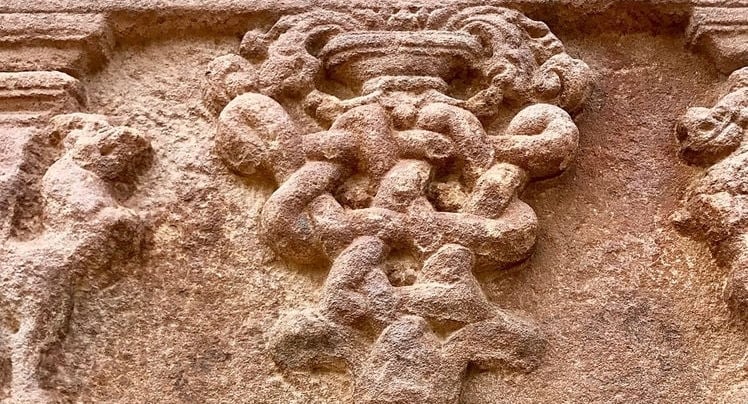Introduction
Ancient Egyptian culture and mythology is one of the oldest and most fascinating in the world. Their beliefs and practices were centered around the concept of life, death, and resurrection, which was reflected in their art, religion, and daily life. The symbols of growth and rebirth played a significant role in this worldview, representing the cycle of life, death, and resurrection. These symbols were used to remind people of the importance of living a good life so that they could achieve eternal life in the afterlife.
The Lotus Flower
The lotus flower is one of the most recognizable symbols of ancient Egypt. This beautiful flower grows in muddy waters and yet emerges from the mud to bloom into a magnificent flower. It was believed that the lotus symbolized the sun, creation, and rebirth. The Egyptians saw the lotus as a symbol of the resurrection of their god Osiris, who was reborn after his death and dismemberment.
In addition to its symbolic importance, the lotus flower had practical uses in ancient Egyptian society. The flowers and seeds were used for food, medicine, and perfumes. The leaves were used to make baskets and mats, while the stems were used to make rope. The lotus flower was also a popular motif in art and was often depicted in tombs, temples, and other religious structures.
The Blue Lotus
Another variety of the lotus flower that was highly valued by the ancient Egyptians was the blue lotus. This flower was believed to have psychoactive properties and was used in religious ceremonies and rituals. The blue lotus was associated with the god Horus and was believed to bring about a state of heightened awareness and spiritual enlightenment.
The Red Lotus
The red lotus was another variety of lotus flower that was important in ancient Egyptian culture. This flower was associated with the god Ra, who was often depicted holding a red lotus in his hand. The red lotus was believed to symbolize the sun, and its petals were thought to represent the sun’s rays.
The Ankh
The Ankh is another important symbol of growth and rebirth in ancient Egypt. This symbol is a looped cross that was often depicted being held by gods and goddesses. The Ankh represented eternal life and was believed to give its bearer the power to overcome death. It was often used in funerary art to show that the deceased had achieved eternal life and was now a part of the divine realm.
The Ankh was also associated with the goddess Isis, who was the mother of Horus and the wife of Osiris. It was believed that Isis was able to use the power of the Ankh to bring about resurrection and renewal. The Ankh was sometimes depicted as a key, which represented the unlocking of the doors to the afterlife.
The Djed Pillar
The Djed pillar is another symbol of growth and rebirth in ancient Egyptian culture. This symbol represented stability, endurance, and strength. The Djed pillar was often depicted as the backbone of the god Osiris and was therefore associated with his resurrection. It was believed that by invoking the power of the Djed pillar, one could achieve strength and stability in both life and the afterlife.
The Was Scepter
The Was scepter was another important symbol in ancient Egyptian culture. This symbol consisted of a long staff with a forked end that was topped with the head of an animal such as a jackal or a falcon. The Was scepter represented power, authority, and dominion over the forces of chaos. It was often used by pharaohs as a symbol of their divine right to rule.
The Scarab Beetle
The scarab beetle was also an important symbol of growth and rebirth in ancient Egypt. This beetle was believed to represent the sun, transformation, and resurrection. The Egyptians saw the scarab as a symbol of the god Khepri, who was believed to roll the sun across the sky each day. The scarab was often used as an amulet or talisman to protect its wearer and to bring about transformation and rebirth.
The scarab beetle was also associated with the god Ra, who was often depicted as a scarab beetle or with a scarab beetle on his head. It was believed that by invoking the power of the scarab beetle, one could achieve transformation and renewal.
The Heart Scarab
One of the most famous uses of the scarab beetle in ancient Egyptian culture was in the form of the heart scarab. This amulet was placed on the chest of the deceased during mummification and was believed to protect the heart during the journey to the afterlife. The heart scarab was inscribed with spells and prayers that would help the deceased pass judgment in the afterlife and achieve eternal life.
The Phoenix
The Phoenix is another symbol of growth and rebirth that was associated with ancient Egyptian culture. This mythical bird was believed to be immortal and would rise from its own ashes after being consumed by fire. The Phoenix was often used as a symbol of resurrection and eternal life, and it was believed that by invoking the power of the Phoenix, one could achieve immortality.
The Phoenix was not originally an Egyptian symbol, but it was adopted by them later on. The bird was associated with the god Bennu, who was depicted as a heron or stork. The Bennu bird was believed to represent creation and rebirth and was often depicted standing on a mound or a tree.
The Importance of Growth and Rebirth
The symbols of growth and rebirth were important in ancient Egyptian culture because they represented the cycle of life and death that was central to their worldview. The Egyptians believed that life was a journey that began at birth, continued through death, and ended in resurrection. The symbols of growth and rebirth represented this journey and were used to remind people of the importance of living a good life so that they could achieve eternal life in the afterlife.
The Egyptians believed that the afterlife was a continuation of the earthly life, and that it was important to prepare for it. They believed that by living a virtuous life and following the teachings of the gods, one could achieve eternal life in the afterlife. The symbols of growth and rebirth were a constant reminder of this goal.
The Role of the Gods
The gods played an important role in the symbolism of growth and rebirth in ancient Egypt. It was believed that the gods had the power to bring about transformation and resurrection. The god Osiris, for example, was seen as the god of resurrection, and his death and resurrection were celebrated in annual festivals. By invoking the power of the gods, people could achieve eternal life and overcome death.
The gods were also seen as protectors and guides for the deceased on their journey to the afterlife. The goddess Ma’at, for example, was associated with truth, justice, and order, and was believed to help guide the deceased through judgment. The god Anubis was associated with mummification and was believed to help prepare the deceased for their journey to the afterlife.
The Influence of Nature
Nature also played an important role in the symbolism of growth and rebirth in ancient Egypt. The Egyptians saw the cycle of the seasons as a reflection of the cycle of life, death, and resurrection. The flooding of the Nile River each year was seen as a symbol of renewal and rebirth, and it was believed that this cycle of flooding and receding was linked to the cycle of life and death.
The Egyptians also believed that the natural world was inhabited by spirits and deities that had the power to bring about growth and transformation. The goddess Hathor, for example, was associated with fertility and was believed to help women conceive and give birth. The god Bes was associated with childbirth and was often depicted as a dwarf with a lion’s mane.
The Symbolism in Art
The symbols of growth and rebirth were often depicted in art in ancient Egypt. Funerary art, for example, often depicted the Ankh or the Djed pillar to show that the deceased had achieved eternal life. The lotus flower was also a popular motif in art, and it was often used to decorate tombs and temples. By using these symbols in art, the Egyptians were able to express their beliefs about life, death, and resurrection.
The art of ancient Egypt was highly symbolic, and every element had a meaning. The colors used in art were also symbolic, with red representing life and vitality, while black represented death and the afterlife. Gold was associated with the gods and royalty and was often used to decorate tombs and sarcophagi.
The Continued Significance Today
The symbols of growth and rebirth continue to be significant today, not only in Egypt but around the world. The lotus flower, for example, is still used as a symbol of spiritual growth and enlightenment in many cultures. The Ankh has become a popular symbol of eternal life in modern times, and it is often used in jewelry and fashion. The continued popularity of these symbols is a testament to their enduring power and relevance.
In addition to their use in art and fashion, the symbols of growth and rebirth are also used in spiritual and religious contexts. The Ankh, for example, is often used in Wiccan and Pagan rituals as a symbol of eternal life and rebirth. The scarab beetle is also used in spiritual practices, with some people believing that it can bring about transformation and renewal.
The Legacy of Egyptian Mythology
The mythology of
What is the symbol of Egyptian rebirth?
The ankh, also known as the key of life or the key of the Nile, is a symbol of everlasting life in Ancient Egyptian culture. It is believed that the ankh was created by Africans and is considered to be the first, or original, cross.
What are the Egyptian symbols of new beginnings?
The serpent is a symbol of new beginnings and introspection in many cultures around the world. In ancient Egyptian mythology, it was used to represent the concept of creation from chaos, as seen in the Book of the Dead, which is believed to have been authored by Thoth.
What is the Egyptian symbol for growth?
Note: The Scarab is an ancient Egyptian symbol for life, death, good luck, transformation, growth, and creation.
What is the Egyptian symbol of healing?
The Eye of Horus
The Eye of Horus, wedjat eye or udjat eye is a concept and symbol in ancient Egyptian religion that represents well-being, healing, and protection.
What is a symbol of growth?
Arrow. The arrow, especially when pointing up, is a symbol of growth.
What is the symbol for growth and change?
Universal Symbol of Change – Lotus. The lotus is symbolic in many cultures as a symbol of change. It represents new beginnings and the ability to rise from the murky waters.
https://www.youtube.com/watch?v=9GE0OrgW1sg&pp=ygUlZWd5cHRpYW4gc3ltYm9sIG9mIGdyb3d0aCBhbmQgcmViaXJ0aA%3D%3D






